IA104 - Power and Leadership Effectiveness: French and Raven's Theory
VerifiedAdded on 2023/06/15
|8
|2254
|196
Essay
AI Summary
This essay delves into French and Raven’s theory of power, explaining its various forms—coercive, reward, legitimate, referent, expert, and informational—and their impact on leadership effectiveness. It analyzes how these power bases are utilized by leaders, providing specific examples of Mahatma Gandhi and Bill Gates. Gandhi is presented as a leader who primarily used referent power through his charisma and non-violent approach, while Bill Gates leveraged legitimate, coercive, and expert power to drive Microsoft's success. The essay concludes that effective leaders create a charismatic personality, inspire their followers, and offer rewards to gain support, ultimately achieving organizational goals through a combination of different power dynamics. Desklib provides access to similar essays and study resources for students.
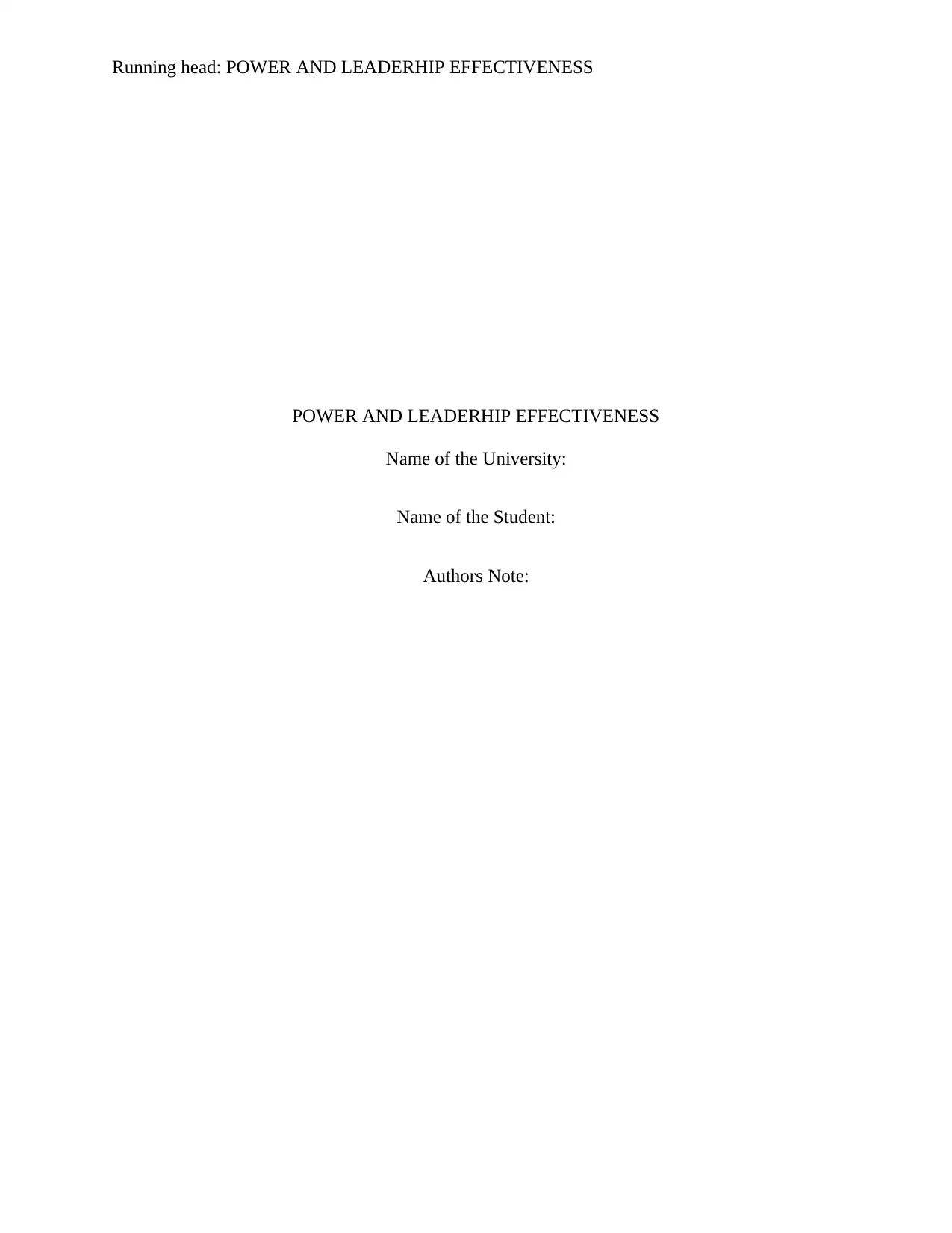
Running head: POWER AND LEADERHIP EFFECTIVENESS
POWER AND LEADERHIP EFFECTIVENESS
Name of the University:
Name of the Student:
Authors Note:
POWER AND LEADERHIP EFFECTIVENESS
Name of the University:
Name of the Student:
Authors Note:
Paraphrase This Document
Need a fresh take? Get an instant paraphrase of this document with our AI Paraphraser
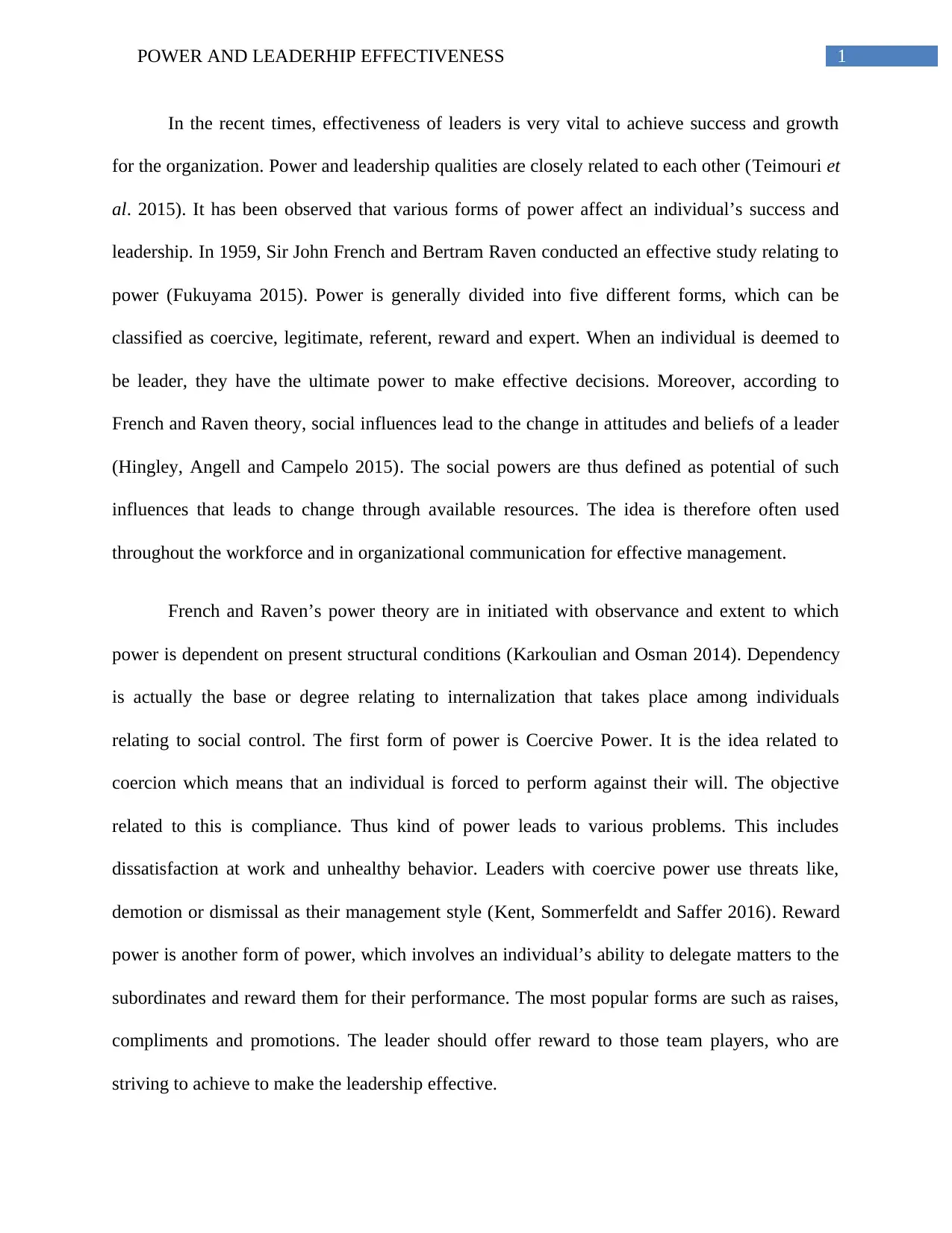
1POWER AND LEADERHIP EFFECTIVENESS
In the recent times, effectiveness of leaders is very vital to achieve success and growth
for the organization. Power and leadership qualities are closely related to each other (Teimouri et
al. 2015). It has been observed that various forms of power affect an individual’s success and
leadership. In 1959, Sir John French and Bertram Raven conducted an effective study relating to
power (Fukuyama 2015). Power is generally divided into five different forms, which can be
classified as coercive, legitimate, referent, reward and expert. When an individual is deemed to
be leader, they have the ultimate power to make effective decisions. Moreover, according to
French and Raven theory, social influences lead to the change in attitudes and beliefs of a leader
(Hingley, Angell and Campelo 2015). The social powers are thus defined as potential of such
influences that leads to change through available resources. The idea is therefore often used
throughout the workforce and in organizational communication for effective management.
French and Raven’s power theory are in initiated with observance and extent to which
power is dependent on present structural conditions (Karkoulian and Osman 2014). Dependency
is actually the base or degree relating to internalization that takes place among individuals
relating to social control. The first form of power is Coercive Power. It is the idea related to
coercion which means that an individual is forced to perform against their will. The objective
related to this is compliance. Thus kind of power leads to various problems. This includes
dissatisfaction at work and unhealthy behavior. Leaders with coercive power use threats like,
demotion or dismissal as their management style (Kent, Sommerfeldt and Saffer 2016). Reward
power is another form of power, which involves an individual’s ability to delegate matters to the
subordinates and reward them for their performance. The most popular forms are such as raises,
compliments and promotions. The leader should offer reward to those team players, who are
striving to achieve to make the leadership effective.
In the recent times, effectiveness of leaders is very vital to achieve success and growth
for the organization. Power and leadership qualities are closely related to each other (Teimouri et
al. 2015). It has been observed that various forms of power affect an individual’s success and
leadership. In 1959, Sir John French and Bertram Raven conducted an effective study relating to
power (Fukuyama 2015). Power is generally divided into five different forms, which can be
classified as coercive, legitimate, referent, reward and expert. When an individual is deemed to
be leader, they have the ultimate power to make effective decisions. Moreover, according to
French and Raven theory, social influences lead to the change in attitudes and beliefs of a leader
(Hingley, Angell and Campelo 2015). The social powers are thus defined as potential of such
influences that leads to change through available resources. The idea is therefore often used
throughout the workforce and in organizational communication for effective management.
French and Raven’s power theory are in initiated with observance and extent to which
power is dependent on present structural conditions (Karkoulian and Osman 2014). Dependency
is actually the base or degree relating to internalization that takes place among individuals
relating to social control. The first form of power is Coercive Power. It is the idea related to
coercion which means that an individual is forced to perform against their will. The objective
related to this is compliance. Thus kind of power leads to various problems. This includes
dissatisfaction at work and unhealthy behavior. Leaders with coercive power use threats like,
demotion or dismissal as their management style (Kent, Sommerfeldt and Saffer 2016). Reward
power is another form of power, which involves an individual’s ability to delegate matters to the
subordinates and reward them for their performance. The most popular forms are such as raises,
compliments and promotions. The leader should offer reward to those team players, who are
striving to achieve to make the leadership effective.

2POWER AND LEADERHIP EFFECTIVENESS
Legitimate power is the power that gives an individual the ability to connect certain
notion of responsibility or obligation towards the management. It is the most recognized form of
power as well as leadership. Often it is regarded as ‘title power’ as the power comes along to the
leader after being appointed to a particular position. The title or power is of great use while it is
held but is eventually goes as the title is taken back (Blois and Hopkinson 2015). CEO, owners
and other executives hold such power. Such kind of power is generally a weak form to convince
and persuade other people. The fourth power is referent power that is based upon the individual’s
right attitude (Özaslan 2017). This is usually the result of individual’s worthiness, perceived
attractiveness and charm. A leader that possesses referent power has good appreciation from
their environment. Therefore tends to have high number of influences. Referent power is often
treated with high admiration and charm. A leader having referent power also has lot of
influences.
The last form of power is expert power, which is based on the individual’s in-depth
information, expertise or knowledge. Leaders having expert powers are highly intelligent and
self-confident. They trust their inner power to fulfill all the roles and responsibilities within the
organization (Hunt 2015). A leader is effectively able to convince their subordinates as a result
of their expert knowledge and power. The expertise of the leader is demonstrated through
actions, credentials and reputations. Recently another form of power is also added by Raven,
Informational power, which is the sixth base of power. Information power is the ability to bring
about change by an agent of influence through adequate informational resources. According to
Raven informational leads to cognition and is accepted by the target of influence. In the age of
digitalization, informational power is rapidly relevant due to the abundance of information that is
easily available. The leaders with informational power possess knowledge that the community
Legitimate power is the power that gives an individual the ability to connect certain
notion of responsibility or obligation towards the management. It is the most recognized form of
power as well as leadership. Often it is regarded as ‘title power’ as the power comes along to the
leader after being appointed to a particular position. The title or power is of great use while it is
held but is eventually goes as the title is taken back (Blois and Hopkinson 2015). CEO, owners
and other executives hold such power. Such kind of power is generally a weak form to convince
and persuade other people. The fourth power is referent power that is based upon the individual’s
right attitude (Özaslan 2017). This is usually the result of individual’s worthiness, perceived
attractiveness and charm. A leader that possesses referent power has good appreciation from
their environment. Therefore tends to have high number of influences. Referent power is often
treated with high admiration and charm. A leader having referent power also has lot of
influences.
The last form of power is expert power, which is based on the individual’s in-depth
information, expertise or knowledge. Leaders having expert powers are highly intelligent and
self-confident. They trust their inner power to fulfill all the roles and responsibilities within the
organization (Hunt 2015). A leader is effectively able to convince their subordinates as a result
of their expert knowledge and power. The expertise of the leader is demonstrated through
actions, credentials and reputations. Recently another form of power is also added by Raven,
Informational power, which is the sixth base of power. Information power is the ability to bring
about change by an agent of influence through adequate informational resources. According to
Raven informational leads to cognition and is accepted by the target of influence. In the age of
digitalization, informational power is rapidly relevant due to the abundance of information that is
easily available. The leaders with informational power possess knowledge that the community
⊘ This is a preview!⊘
Do you want full access?
Subscribe today to unlock all pages.

Trusted by 1+ million students worldwide

3POWER AND LEADERHIP EFFECTIVENESS
needs or want. It is actually a transitory form of power as the power is given away, when passes
one information to other. French and Raven’s prior five forms of power are fully independent of
the content (Blois and Hopkinson 2015).
Mohandas Karamchand Gandhi is popularly recognized as the greatest spiritual and
political leader of twentieth century. His power of non-violence and love is one of his key assets.
Due to his stature, presently he is considered as Mahatma, which means ‘great soul’ (Nayak
2018). Mahatma Gandhi was a visionary and empowering leader, who possessed the referent
power as per French and Raven’s theory. Mahatma Gandhi proved to be an empowering leader
not only as he empowered the Indians throughout the nation to corrupt the British Empire. Since,
he was a true pioneer of Satyagraha. He was not only a mere politician but a man of vision and a
great statesman. In India, Gandhi established himself as the slave of people and thus empowered
the general public. He made it a firm policy to practice according to his preach. Just like many in
the country, he resorted himself to simple living. Therefore, people looked up to him as their
leader and guide. He had great motivational and communication skills (Kent, Sommerfeldt and
Saffer 2016).
Gandhi was also popular in South Africa because of his movements and works. His non-
violent management or leadership style was very well respected in the Indian style. He proved
himself to be a transformational leader as he always motivated and empowered his followers
towards success. With his charm and outstanding personality he gave the people hope when there
was none (Higgs and Dulewicz 2016). In the modern history, Mahatma Gandhi is regarded as
one of the great transformational leader due to his self-confidence and long term- vision. While
leading several campaigns nationwide he applied his motivational and strategic planning skills.
Mahatma Gandhi appeals influencing tactics that is based on friendship and loyalty. He
needs or want. It is actually a transitory form of power as the power is given away, when passes
one information to other. French and Raven’s prior five forms of power are fully independent of
the content (Blois and Hopkinson 2015).
Mohandas Karamchand Gandhi is popularly recognized as the greatest spiritual and
political leader of twentieth century. His power of non-violence and love is one of his key assets.
Due to his stature, presently he is considered as Mahatma, which means ‘great soul’ (Nayak
2018). Mahatma Gandhi was a visionary and empowering leader, who possessed the referent
power as per French and Raven’s theory. Mahatma Gandhi proved to be an empowering leader
not only as he empowered the Indians throughout the nation to corrupt the British Empire. Since,
he was a true pioneer of Satyagraha. He was not only a mere politician but a man of vision and a
great statesman. In India, Gandhi established himself as the slave of people and thus empowered
the general public. He made it a firm policy to practice according to his preach. Just like many in
the country, he resorted himself to simple living. Therefore, people looked up to him as their
leader and guide. He had great motivational and communication skills (Kent, Sommerfeldt and
Saffer 2016).
Gandhi was also popular in South Africa because of his movements and works. His non-
violent management or leadership style was very well respected in the Indian style. He proved
himself to be a transformational leader as he always motivated and empowered his followers
towards success. With his charm and outstanding personality he gave the people hope when there
was none (Higgs and Dulewicz 2016). In the modern history, Mahatma Gandhi is regarded as
one of the great transformational leader due to his self-confidence and long term- vision. While
leading several campaigns nationwide he applied his motivational and strategic planning skills.
Mahatma Gandhi appeals influencing tactics that is based on friendship and loyalty. He
Paraphrase This Document
Need a fresh take? Get an instant paraphrase of this document with our AI Paraphraser
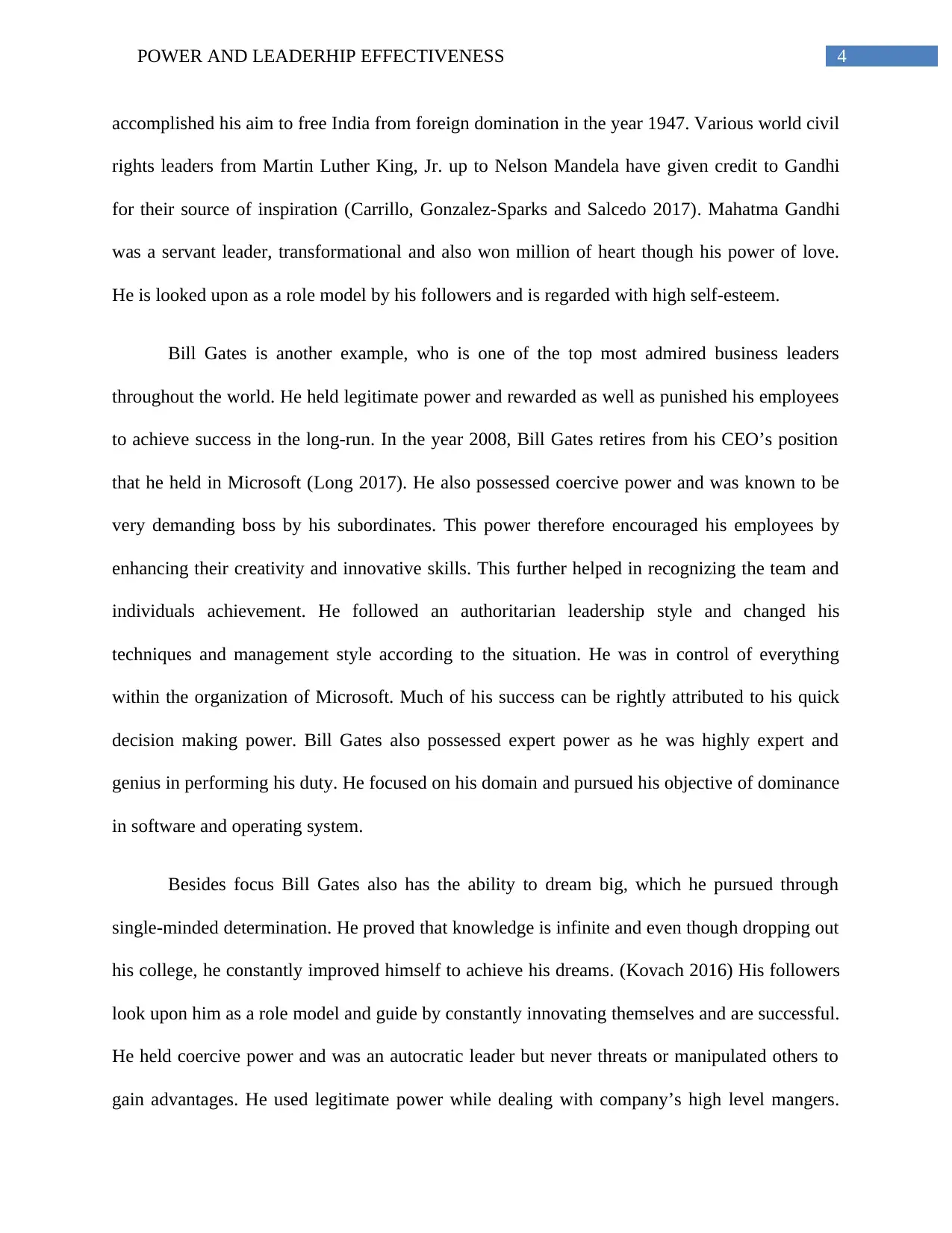
4POWER AND LEADERHIP EFFECTIVENESS
accomplished his aim to free India from foreign domination in the year 1947. Various world civil
rights leaders from Martin Luther King, Jr. up to Nelson Mandela have given credit to Gandhi
for their source of inspiration (Carrillo, Gonzalez-Sparks and Salcedo 2017). Mahatma Gandhi
was a servant leader, transformational and also won million of heart though his power of love.
He is looked upon as a role model by his followers and is regarded with high self-esteem.
Bill Gates is another example, who is one of the top most admired business leaders
throughout the world. He held legitimate power and rewarded as well as punished his employees
to achieve success in the long-run. In the year 2008, Bill Gates retires from his CEO’s position
that he held in Microsoft (Long 2017). He also possessed coercive power and was known to be
very demanding boss by his subordinates. This power therefore encouraged his employees by
enhancing their creativity and innovative skills. This further helped in recognizing the team and
individuals achievement. He followed an authoritarian leadership style and changed his
techniques and management style according to the situation. He was in control of everything
within the organization of Microsoft. Much of his success can be rightly attributed to his quick
decision making power. Bill Gates also possessed expert power as he was highly expert and
genius in performing his duty. He focused on his domain and pursued his objective of dominance
in software and operating system.
Besides focus Bill Gates also has the ability to dream big, which he pursued through
single-minded determination. He proved that knowledge is infinite and even though dropping out
his college, he constantly improved himself to achieve his dreams. (Kovach 2016) His followers
look upon him as a role model and guide by constantly innovating themselves and are successful.
He held coercive power and was an autocratic leader but never threats or manipulated others to
gain advantages. He used legitimate power while dealing with company’s high level mangers.
accomplished his aim to free India from foreign domination in the year 1947. Various world civil
rights leaders from Martin Luther King, Jr. up to Nelson Mandela have given credit to Gandhi
for their source of inspiration (Carrillo, Gonzalez-Sparks and Salcedo 2017). Mahatma Gandhi
was a servant leader, transformational and also won million of heart though his power of love.
He is looked upon as a role model by his followers and is regarded with high self-esteem.
Bill Gates is another example, who is one of the top most admired business leaders
throughout the world. He held legitimate power and rewarded as well as punished his employees
to achieve success in the long-run. In the year 2008, Bill Gates retires from his CEO’s position
that he held in Microsoft (Long 2017). He also possessed coercive power and was known to be
very demanding boss by his subordinates. This power therefore encouraged his employees by
enhancing their creativity and innovative skills. This further helped in recognizing the team and
individuals achievement. He followed an authoritarian leadership style and changed his
techniques and management style according to the situation. He was in control of everything
within the organization of Microsoft. Much of his success can be rightly attributed to his quick
decision making power. Bill Gates also possessed expert power as he was highly expert and
genius in performing his duty. He focused on his domain and pursued his objective of dominance
in software and operating system.
Besides focus Bill Gates also has the ability to dream big, which he pursued through
single-minded determination. He proved that knowledge is infinite and even though dropping out
his college, he constantly improved himself to achieve his dreams. (Kovach 2016) His followers
look upon him as a role model and guide by constantly innovating themselves and are successful.
He held coercive power and was an autocratic leader but never threats or manipulated others to
gain advantages. He used legitimate power while dealing with company’s high level mangers.
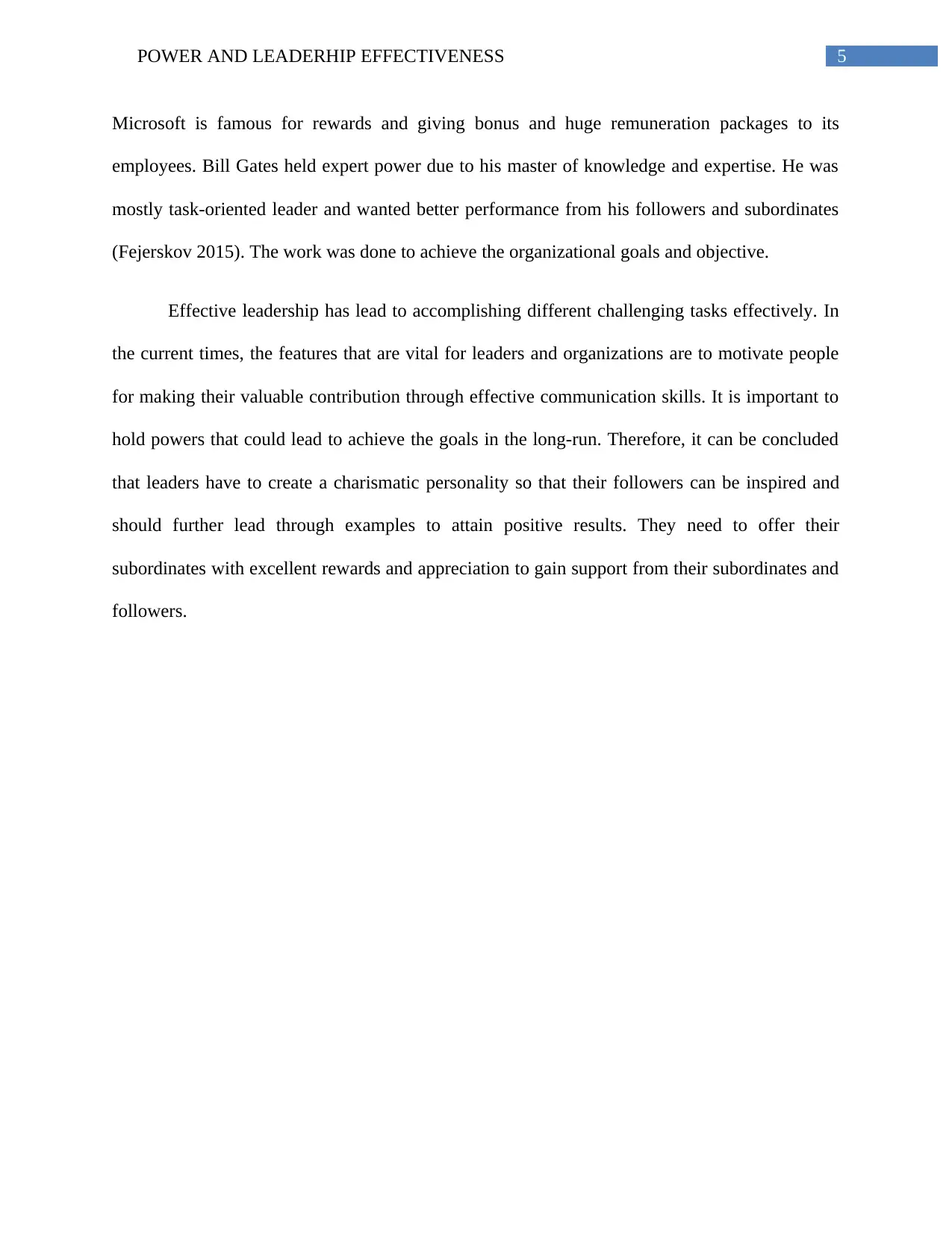
5POWER AND LEADERHIP EFFECTIVENESS
Microsoft is famous for rewards and giving bonus and huge remuneration packages to its
employees. Bill Gates held expert power due to his master of knowledge and expertise. He was
mostly task-oriented leader and wanted better performance from his followers and subordinates
(Fejerskov 2015). The work was done to achieve the organizational goals and objective.
Effective leadership has lead to accomplishing different challenging tasks effectively. In
the current times, the features that are vital for leaders and organizations are to motivate people
for making their valuable contribution through effective communication skills. It is important to
hold powers that could lead to achieve the goals in the long-run. Therefore, it can be concluded
that leaders have to create a charismatic personality so that their followers can be inspired and
should further lead through examples to attain positive results. They need to offer their
subordinates with excellent rewards and appreciation to gain support from their subordinates and
followers.
Microsoft is famous for rewards and giving bonus and huge remuneration packages to its
employees. Bill Gates held expert power due to his master of knowledge and expertise. He was
mostly task-oriented leader and wanted better performance from his followers and subordinates
(Fejerskov 2015). The work was done to achieve the organizational goals and objective.
Effective leadership has lead to accomplishing different challenging tasks effectively. In
the current times, the features that are vital for leaders and organizations are to motivate people
for making their valuable contribution through effective communication skills. It is important to
hold powers that could lead to achieve the goals in the long-run. Therefore, it can be concluded
that leaders have to create a charismatic personality so that their followers can be inspired and
should further lead through examples to attain positive results. They need to offer their
subordinates with excellent rewards and appreciation to gain support from their subordinates and
followers.
⊘ This is a preview!⊘
Do you want full access?
Subscribe today to unlock all pages.

Trusted by 1+ million students worldwide

6POWER AND LEADERHIP EFFECTIVENESS
References:
Blois, K.J. and Hopkinson, G.C., 2015. Rejoinder to Hunt’s ‘The bases of power approach to
channel relationships’. Journal of Marketing Management, 31(7-8), pp.765-773.
Carrillo, M., Gonzalez-Sparks, A. and Salcedo, N.U., 2017. Relationship Between Legitimate
and Expert Social Power Types of Preadolescent Children on the Influence Perception in Their
Mothers’ Purchasing Behavior in Peruvian Toy Stores. In Creating Marketing Magic and
Innovative Future Marketing Trends (pp. 371-388). Springer, Cham.
Fejerskov, A.M., 2015. From unconventional to ordinary? The Bill and Melinda Gates
Foundation and the homogenizing effects of international development cooperation. Journal of
International Development, 27(7), pp.1098-1112.
Fukuyama, F., 2015. Why is democracy performing so poorly?. Journal of Democracy, 26(1),
pp.11-20.
Higgs, M. and Dulewicz, V., 2016. Developments in leadership thinking. In Leading with
Emotional Intelligence (pp. 75-103). Palgrave Macmillan, Cham.
Hingley, M., Angell, R. and Campelo, A., 2015. Introduction to the special issue on power in
business, customer, and market relationships. Industrial Marketing Management, 48, pp.101-
102.
Hunt, S.D., 2015. The bases of power approach to channel relationships: has marketing’s
scholarship been misguided?. Journal of Marketing Management, 31(7-8), pp.747-764.
References:
Blois, K.J. and Hopkinson, G.C., 2015. Rejoinder to Hunt’s ‘The bases of power approach to
channel relationships’. Journal of Marketing Management, 31(7-8), pp.765-773.
Carrillo, M., Gonzalez-Sparks, A. and Salcedo, N.U., 2017. Relationship Between Legitimate
and Expert Social Power Types of Preadolescent Children on the Influence Perception in Their
Mothers’ Purchasing Behavior in Peruvian Toy Stores. In Creating Marketing Magic and
Innovative Future Marketing Trends (pp. 371-388). Springer, Cham.
Fejerskov, A.M., 2015. From unconventional to ordinary? The Bill and Melinda Gates
Foundation and the homogenizing effects of international development cooperation. Journal of
International Development, 27(7), pp.1098-1112.
Fukuyama, F., 2015. Why is democracy performing so poorly?. Journal of Democracy, 26(1),
pp.11-20.
Higgs, M. and Dulewicz, V., 2016. Developments in leadership thinking. In Leading with
Emotional Intelligence (pp. 75-103). Palgrave Macmillan, Cham.
Hingley, M., Angell, R. and Campelo, A., 2015. Introduction to the special issue on power in
business, customer, and market relationships. Industrial Marketing Management, 48, pp.101-
102.
Hunt, S.D., 2015. The bases of power approach to channel relationships: has marketing’s
scholarship been misguided?. Journal of Marketing Management, 31(7-8), pp.747-764.
Paraphrase This Document
Need a fresh take? Get an instant paraphrase of this document with our AI Paraphraser
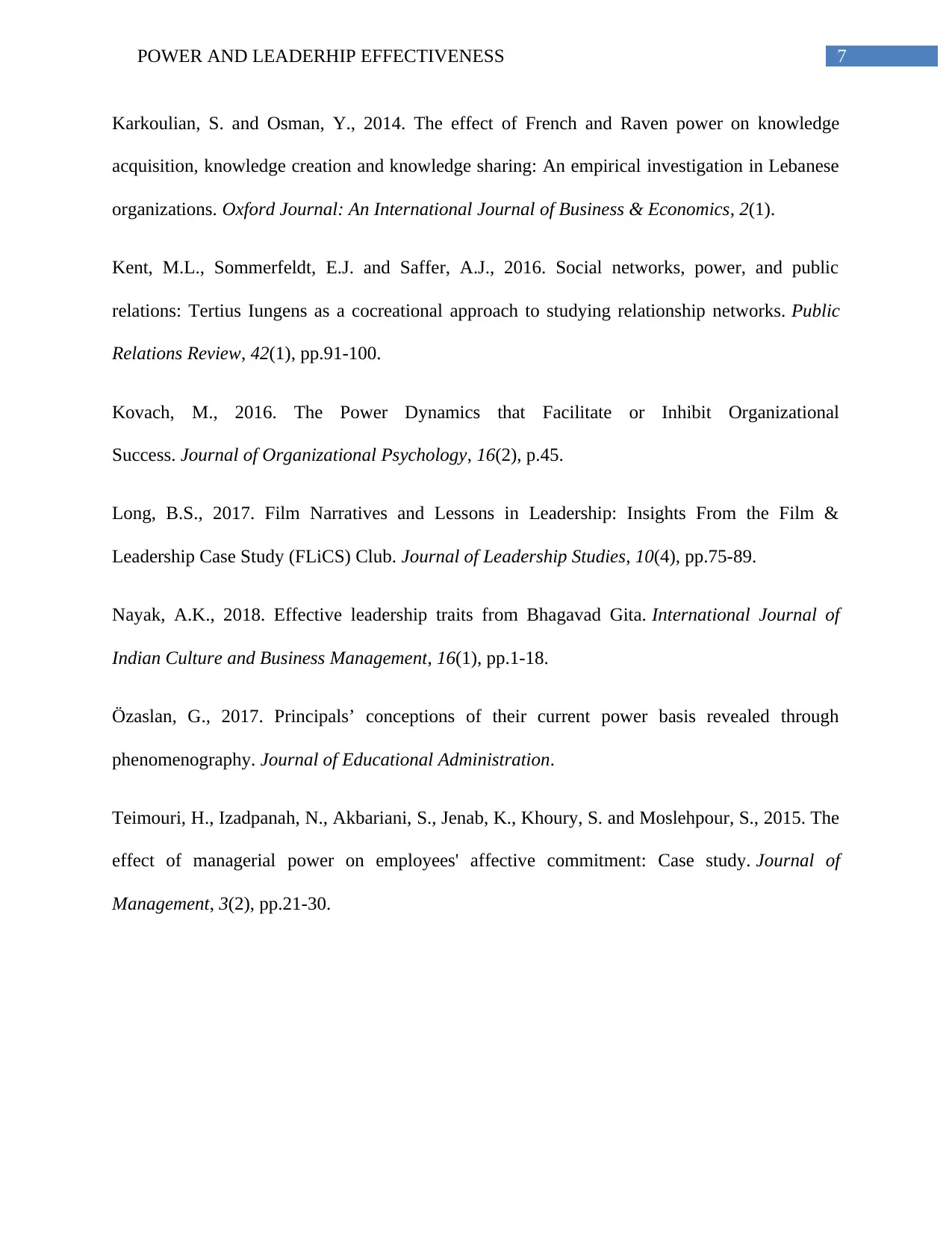
7POWER AND LEADERHIP EFFECTIVENESS
Karkoulian, S. and Osman, Y., 2014. The effect of French and Raven power on knowledge
acquisition, knowledge creation and knowledge sharing: An empirical investigation in Lebanese
organizations. Oxford Journal: An International Journal of Business & Economics, 2(1).
Kent, M.L., Sommerfeldt, E.J. and Saffer, A.J., 2016. Social networks, power, and public
relations: Tertius Iungens as a cocreational approach to studying relationship networks. Public
Relations Review, 42(1), pp.91-100.
Kovach, M., 2016. The Power Dynamics that Facilitate or Inhibit Organizational
Success. Journal of Organizational Psychology, 16(2), p.45.
Long, B.S., 2017. Film Narratives and Lessons in Leadership: Insights From the Film &
Leadership Case Study (FLiCS) Club. Journal of Leadership Studies, 10(4), pp.75-89.
Nayak, A.K., 2018. Effective leadership traits from Bhagavad Gita. International Journal of
Indian Culture and Business Management, 16(1), pp.1-18.
Özaslan, G., 2017. Principals’ conceptions of their current power basis revealed through
phenomenography. Journal of Educational Administration.
Teimouri, H., Izadpanah, N., Akbariani, S., Jenab, K., Khoury, S. and Moslehpour, S., 2015. The
effect of managerial power on employees' affective commitment: Case study. Journal of
Management, 3(2), pp.21-30.
Karkoulian, S. and Osman, Y., 2014. The effect of French and Raven power on knowledge
acquisition, knowledge creation and knowledge sharing: An empirical investigation in Lebanese
organizations. Oxford Journal: An International Journal of Business & Economics, 2(1).
Kent, M.L., Sommerfeldt, E.J. and Saffer, A.J., 2016. Social networks, power, and public
relations: Tertius Iungens as a cocreational approach to studying relationship networks. Public
Relations Review, 42(1), pp.91-100.
Kovach, M., 2016. The Power Dynamics that Facilitate or Inhibit Organizational
Success. Journal of Organizational Psychology, 16(2), p.45.
Long, B.S., 2017. Film Narratives and Lessons in Leadership: Insights From the Film &
Leadership Case Study (FLiCS) Club. Journal of Leadership Studies, 10(4), pp.75-89.
Nayak, A.K., 2018. Effective leadership traits from Bhagavad Gita. International Journal of
Indian Culture and Business Management, 16(1), pp.1-18.
Özaslan, G., 2017. Principals’ conceptions of their current power basis revealed through
phenomenography. Journal of Educational Administration.
Teimouri, H., Izadpanah, N., Akbariani, S., Jenab, K., Khoury, S. and Moslehpour, S., 2015. The
effect of managerial power on employees' affective commitment: Case study. Journal of
Management, 3(2), pp.21-30.
1 out of 8
Related Documents
Your All-in-One AI-Powered Toolkit for Academic Success.
+13062052269
info@desklib.com
Available 24*7 on WhatsApp / Email
![[object Object]](/_next/static/media/star-bottom.7253800d.svg)
Unlock your academic potential
Copyright © 2020–2025 A2Z Services. All Rights Reserved. Developed and managed by ZUCOL.





